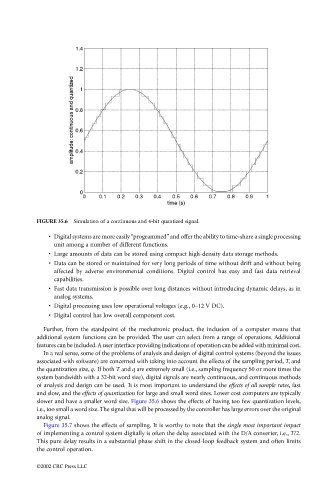Page 1028 - The Mechatronics Handbook
P. 1028
FIGURE 35.6 Simulation of a continuous and 4-bit quantized signal.
• Digital systems are more easily “programmed” and offer the ability to time-share a single processing
unit among a number of different functions.
• Large amounts of data can be stored using compact high-density data storage methods.
• Data can be stored or maintained for very long periods of time without drift and without being
affected by adverse environmental conditions. Digital control has easy and fast data retrieval
capabilities.
• Fast data transmission is possible over long distances without introducing dynamic delays, as in
analog systems.
• Digital processing uses low operational voltages (e.g., 0–12 V DC).
• Digital control has low overall component cost.
Further, from the standpoint of the mechatronic product, the inclusion of a computer means that
additional system functions can be provided. The user can select from a range of operations. Additional
features can be included. A user interface providing indications of operation can be added with minimal cost.
In a real sense, some of the problems of analysis and design of digital control systems (beyond the issues
associated with software) are concerned with taking into account the effects of the sampling period, T, and
the quantization size, q. If both T and q are extremely small (i.e., sampling frequency 50 or more times the
system bandwidth with a 32-bit word size), digital signals are nearly continuous, and continuous methods
of analysis and design can be used. It is most important to understand the effects of all sample rates, fast
and slow, and the effects of quantization for large and small word sizes. Lower cost computers are typically
slower and have a smaller word size. Figure 35.6 shows the effects of having too few quantization levels,
i.e., too small a word size. The signal that will be processed by the controller has large errors over the original
analog signal.
Figure 35.7 shows the effects of sampling. It is worthy to note that the single most important impact
of implementing a control system digitally is often the delay associated with the D/A converter, i.e., T/2.
This pure delay results in a substantial phase shift in the closed-loop feedback system and often limits
the control operation.
©2002 CRC Press LLC

